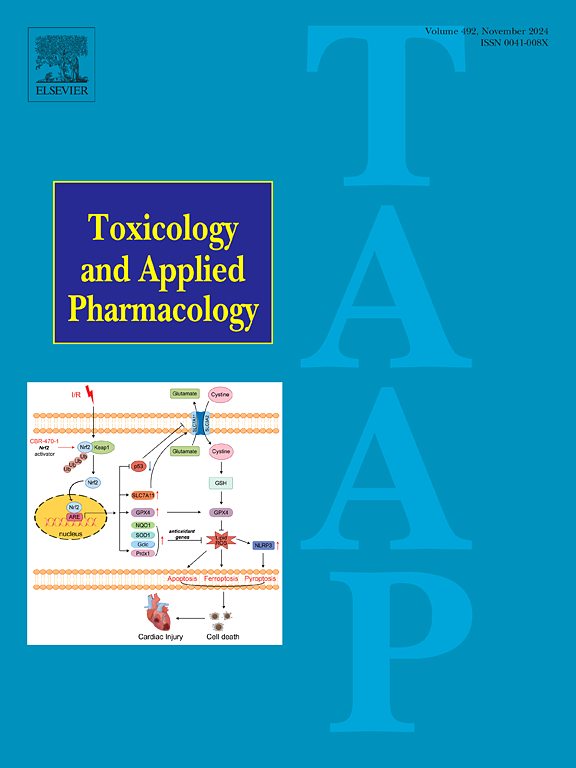The role of tungsten in modulating DNA double-strand break repair and class switch recombination
IF 3.4
3区 医学
Q2 PHARMACOLOGY & PHARMACY
引用次数: 0
Abstract
Tungsten, a transition metal with widespread applications, is increasingly recognized as an environmental contaminant with potential health impacts. While tungsten exposure has been previously associated with increased DNA damage, its specific effects on DNA repair mechanisms remain poorly understood. Here, we found that tungsten alone did not induce DNA damage in vitro, as assessed by γ-H2AX phosphorylation. However, tungsten exacerbated DNA double-strand breaks induced by genotoxic agents, delayed γ-H2AX resolution, and induced cell cycle arrest. Mechanistically, GFP-based reporter assays revealed that tungsten impairs both homologous recombination (HR) and non-homologous end joining (NHEJ), which coincided with reduced recruitment of critical repair proteins, including BRCA1, 53BP1, and ATM at DSB sites. To assess functional consequences of impaired DNA repair due to tungsten exposure, we examined immunoglobulin (Ig) class switch recombination (CSR), a critical antibody diversification process reliant on the repair of DSBs. Using the CH12F3 B cell line, we showed that tungsten significantly impaired cytokine stimulated-CSR from IgM to IgA without affecting cell proliferation or activation-induced cytidine deaminase (Aicda) expression. Furthermore, ex vivo activation of splenic B cells confirmed that tungsten exposure inhibits CSR from IgM to IgG1, independent of cell proliferation. Together, these data indicate that tungsten exposure impairs canonical DSB repair pathways and CSR, highlighting the potential consequences for immune function upon environmental or occupational exposure to tungsten.

钨在调节DNA双链断裂修复和类开关重组中的作用。
钨作为一种应用广泛的过渡金属,越来越被认为是一种具有潜在健康影响的环境污染物。虽然钨暴露以前与DNA损伤增加有关,但其对DNA修复机制的具体影响仍然知之甚少。在这里,我们发现单独钨不会诱导体外DNA损伤,通过γ-H2AX磷酸化来评估。然而,钨加剧了基因毒性物质诱导的DNA双链断裂,延迟了γ-H2AX的分辨率,并诱导细胞周期阻滞。在机制上,基于gfp的报告基因分析显示,钨损害同源重组(HR)和非同源末端连接(NHEJ),这与DSB位点上关键修复蛋白(包括BRCA1、53BP1和ATM)的募集减少相一致。为了评估钨暴露导致的DNA修复受损的功能后果,我们检测了免疫球蛋白(Ig)类开关重组(CSR),这是一个依赖于dsb修复的关键抗体多样化过程。在ch12f3b细胞系中,我们发现钨显著破坏了细胞因子刺激从IgM到IgA的csr,而不影响细胞增殖或激活诱导的胞苷脱氨酶(Aicda)的表达。此外,脾B细胞的体外活化证实,钨暴露可抑制IgM到IgG1的CSR,不依赖于细胞增殖。总之,这些数据表明钨暴露会损害典型的DSB修复途径和CSR,突出了环境或职业钨暴露对免疫功能的潜在影响。
本文章由计算机程序翻译,如有差异,请以英文原文为准。
求助全文
约1分钟内获得全文
求助全文
来源期刊
CiteScore
6.80
自引率
2.60%
发文量
309
审稿时长
32 days
期刊介绍:
Toxicology and Applied Pharmacology publishes original scientific research of relevance to animals or humans pertaining to the action of chemicals, drugs, or chemically-defined natural products.
Regular articles address mechanistic approaches to physiological, pharmacologic, biochemical, cellular, or molecular understanding of toxicologic/pathologic lesions and to methods used to describe these responses. Safety Science articles address outstanding state-of-the-art preclinical and human translational characterization of drug and chemical safety employing cutting-edge science. Highly significant Regulatory Safety Science articles will also be considered in this category. Papers concerned with alternatives to the use of experimental animals are encouraged.
Short articles report on high impact studies of broad interest to readers of TAAP that would benefit from rapid publication. These articles should contain no more than a combined total of four figures and tables. Authors should include in their cover letter the justification for consideration of their manuscript as a short article.

 求助内容:
求助内容: 应助结果提醒方式:
应助结果提醒方式:


